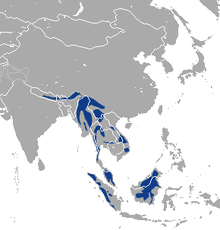Pardofelis
| Pardofelis | |
|---|---|
 | |
| Illustration of Catolynx marmoratus[1] | |
| Scientific classification | |
| Domain: | Eukaryota |
| Kingdom: | Animalia |
| Phylum: | Chordata |
| Class: | Mammalia |
| Order: | Carnivora |
| Suborder: | Feliformia |
| Family: | Felidae |
| Subfamily: | Felinae |
| Genus: | Pardofelis Severtzov, 1858 |
| Species | |
 | |
| Marbled cat range | |
Pardofelis is a genus of the cat family Felidae.[2] This genus is defined as including one species native to Southeast Asia: the marbled cat.[3] Two other species, formerly classified to this genus, now belong to the genus Catopuma.
The word pardofelis is composed of the Latin words pardus (pard), and felis (cat) in allusion to the spots of the type species, the marbled cat.[4]
Taxonomic history
[edit]Pardofelis was first proposed by the Russian explorer and naturalist Nikolai Severtzov in 1858 as generic name comprising a single felid species occurring in tropical Asia, the marbled cat Pardofelis marmorata.[5] The British zoologist Reginald Innes Pocock recognized the taxonomic classification of Pardofelis in 1917 as comprising not only the marbled cat but also the Borneo bay cat Pardofelis badia, because of similarities in the shape of their skulls.[2] In 1939, he described Pardofelis marmorata on the basis of skins and skulls which originated in Java, Sumatra, Darjeeling and Sikkim.[6]
Until 2006, the classification of Pardofelis as a monotypic genus was widely accepted.[7] Genetic analysis carried out at the turn of the century revealed a close genetic relationship with the Borneo bay cat Pardofelis badia and the Asian golden cat Pardofelis temminckii. All of them diverged from the other felids about 9.4 million years ago, and have therefore been proposed to be placed in the genus Pardofelis.[3] Meanwhile, Pardofelis is considered a synonym of Catopuma.[8][9]
The relationship between this branch and others on the feline family tree has also become clearer. Pardofelis species do not stem from the Pantherinae subfamily but belong to the other main branch of mostly smaller cat species, the Felinae. They share a more recent common ancestor with servals, caracals, and African golden cats than with any other existing cat genus.[3][10][11]
Characteristics
[edit]Pardofelis are small long-tailed, short-headed cats with rounded ears, distinguishable from Prionailurus and related Oriental genera by having the skull higher and more rounded, with the mesopterygoid fossa lanceolate in front and provided with thickened margins or a better developed external crest.[2] The skull is short, broad, strongly convex in dorsal profile, not comparatively long and low. The nasal branch of the premaxilla is thin, not expanded, the summit of the muzzle is not compressed above, the maxilla is not expanded where it abuts against the nasal bone, and develops no excrescence outside the suborbital foramen.[6]
References
[edit]- ^ Lydekker, R. (1896). A Handbook to the Carnivora: part 1: Cats, Civets, and Mongooses. Edward Lloyd Limited, London
- ^ a b c Pocock, R. I. (1917). "The classification of the existing Felidae". Annals and Magazine of Natural History. Series 8. XX (119): 329–350. doi:10.1080/00222931709487018.
- ^ a b c Johnson, W. E.; Eizirik, E.; Pecon-Slattery, J.; Murphy, W. J.; Antunes, A.; Teeling, E.; O'Brien, S. J. (2006). "The Late Miocene Radiation of Modern Felidae: A Genetic Assessment". Science. 311 (5757): 73–77. Bibcode:2006Sci...311...73J. doi:10.1126/science.1122277. PMID 16400146. S2CID 41672825.
- ^ Palmer, T. S.; Merriam, C. H. (1904). Index generum mammalium: a list of the genera and families of mammals. Government Printing Office, Washington.
- ^ Severtzow, M. N. (1858). "Notice sur la classification multisériale des Carnivores, spécialement des Félidés, et les études de zoologie générale qui s'y rattachent". Revue et Magasin de Zoologie Pure et Appliquée. 2. Séptembre: 385–396.
- ^ a b Pocock, R. I. (1939). "Pardofelis". The fauna of British India, including Ceylon and Burma. Vol. Mammalia. – Volume 1. London: Taylor and Francis. pp. 253–258.
- ^ Wozencraft, W. C. (2005). "Genus Pardofelis". In Wilson, D. E.; Reeder, D. M. (eds.). Mammal Species of the World: A Taxonomic and Geographic Reference (3rd ed.). Johns Hopkins University Press. pp. 545–546. ISBN 978-0-8018-8221-0. OCLC 62265494.
- ^ Hearn, A.; Brodie, J.; Cheyne, S.; Loken, B.; Ross, J.; Wilting, A. (2016). "Catopuma badia". IUCN Red List of Threatened Species. 2016: e.T4037A112910221.
- ^ McCarthy, J.; Dahal, S.; Dhendup, T.; Gray, T.N.E.; Mukherjee, S.; Rahman, H.; Riordan, P.; Boontua, N. & Wilcox, D. (2015). "Catopuma temminckii". IUCN Red List of Threatened Species. 2015: e.T4038A97165437.
- ^ O'Brien, S.J.; Johnson, W.E. (2005). "Big cat genomics". Annual Review of Genomics and Human Genetics. 6 (1): 407–429. doi:10.1146/annurev.genom.6.080604.162151. PMID 16124868.
- ^ Johnson, W.E.; O'Brien, S.J. (1997). "Phylogenetic reconstruction of the Felidae using 16S rRNA and NADH-5 mitochondrial genes". Journal of Molecular Evolution. 44 (Supplement 1): 98–116. Bibcode:1997JMolE..44S..98J. doi:10.1007/PL00000060. PMID 9071018. S2CID 40185850.


 French
French Deutsch
Deutsch